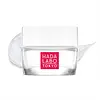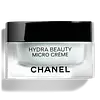What's inside
What's inside
 Key Ingredients
Key Ingredients

 Benefits
Benefits

 Concerns
Concerns

 Ingredients Side-by-side
Ingredients Side-by-side

Water
Skin ConditioningDipropylene Glycol
HumectantGlycerin
HumectantPentylene Glycol
Skin ConditioningButylene Glycol
HumectantPEG-240/Hdi Copolymer Bis-Decyltetradeceth-20 Ether
StabilisingPPG-17-Buteth-17
Skin ConditioningTriethylhexanoin
MaskingPEG-8
HumectantSorbitol
HumectantPolysorbate 60
EmulsifyingInositol
HumectantPhenoxyethanol
PreservativePropanediol
SolventSorbitan Sesquioleate
EmulsifyingSodium Citrate
BufferingBeheneth-30
CleansingPolyacrylate Crosspolymer-11
Emulsion StabilisingHydrolyzed Hyaluronic Acid
HumectantLactobacillus/Soymilk Ferment Filtrate
Skin ConditioningDisodium EDTA
Citric Acid
BufferingCaprylhydroxamic Acid
Sodium Acetylated Hyaluronate
HumectantPropylene Glycol
HumectantSodium Hyaluronate
HumectantPotassium Laurate
EmulsifyingTocopherol
AntioxidantAlcohol Denat.
AntimicrobialPanax Ginseng Root Extract
EmollientSodium Hyaluronate Crosspolymer
HumectantHydroxyacetophenone
AntioxidantSodium Chloride
MaskingWater, Dipropylene Glycol, Glycerin, Pentylene Glycol, Butylene Glycol, PEG-240/Hdi Copolymer Bis-Decyltetradeceth-20 Ether, PPG-17-Buteth-17, Triethylhexanoin, PEG-8, Sorbitol, Polysorbate 60, Inositol, Phenoxyethanol, Propanediol, Sorbitan Sesquioleate, Sodium Citrate, Beheneth-30, Polyacrylate Crosspolymer-11, Hydrolyzed Hyaluronic Acid, Lactobacillus/Soymilk Ferment Filtrate, Disodium EDTA, Citric Acid, Caprylhydroxamic Acid, Sodium Acetylated Hyaluronate, Propylene Glycol, Sodium Hyaluronate, Potassium Laurate, Tocopherol, Alcohol Denat., Panax Ginseng Root Extract, Sodium Hyaluronate Crosspolymer, Hydroxyacetophenone, Sodium Chloride
Water
Skin ConditioningGlycerin
HumectantAlcohol
AntimicrobialPropanediol
SolventButylene Glycol
HumectantIsodecyl Neopentanoate
EmollientIsononyl Isononanoate
EmollientPentylene Glycol
Skin ConditioningIsododecane
EmollientJojoba Esters
EmollientCamellia Japonica Flower Extract
EmollientZingiber Officinale Root Extract
MaskingButyrospermum Parkii Butter
Skin ConditioningMethyl Methacrylate Crosspolymer
Nylon-6
Phenoxyethanol
PreservativeDextrin Palmitate
EmulsifyingNeopentyl Glycol Diheptanoate
EmollientSqualane
EmollientHydrogenated Polydecene
EmollientSodium Acrylates/C10-30 Alkyl Acrylate Crosspolymer
Parfum
MaskingSodium Carbomer
Emulsion StabilisingDipropylene Glycol
HumectantHydroxystearic Acid
CleansingSodium Palmitate
CleansingDisodium EDTA
Amodimethicone
Sodium Citrate
BufferingPalmitic Acid
EmollientSodium Hyaluronate
HumectantT-Butyl Alcohol
PerfumingTocopherol
AntioxidantOctyldodecyl Myristate
EmollientDenatonium Benzoate
MaskingCitric Acid
BufferingCI 42090
Cosmetic ColorantCI 77510
Cosmetic ColorantWater, Glycerin, Alcohol, Propanediol, Butylene Glycol, Isodecyl Neopentanoate, Isononyl Isononanoate, Pentylene Glycol, Isododecane, Jojoba Esters, Camellia Japonica Flower Extract, Zingiber Officinale Root Extract, Butyrospermum Parkii Butter, Methyl Methacrylate Crosspolymer, Nylon-6, Phenoxyethanol, Dextrin Palmitate, Neopentyl Glycol Diheptanoate, Squalane, Hydrogenated Polydecene, Sodium Acrylates/C10-30 Alkyl Acrylate Crosspolymer, Parfum, Sodium Carbomer, Dipropylene Glycol, Hydroxystearic Acid, Sodium Palmitate, Disodium EDTA, Amodimethicone, Sodium Citrate, Palmitic Acid, Sodium Hyaluronate, T-Butyl Alcohol, Tocopherol, Octyldodecyl Myristate, Denatonium Benzoate, Citric Acid, CI 42090, CI 77510
Ingredients Explained
These ingredients are found in both products.
Ingredients higher up in an ingredient list are typically present in a larger amount.
Butylene Glycol (or BG) is used within cosmetic products for a few different reasons:
Overall, Butylene Glycol is a safe and well-rounded ingredient that works well with other ingredients.
Though this ingredient works well with most skin types, some people with sensitive skin may experience a reaction such as allergic rashes, closed comedones, or itchiness.
Learn more about Butylene GlycolCitric Acid is an alpha hydroxy acid (AHA) naturally found in citrus fruits like oranges, lemons, and limes.
Like other AHAs, citric acid can exfoliate skin by breaking down the bonds that hold dead skin cells together. This helps reveal smoother and brighter skin underneath.
However, this exfoliating effect only happens at high concentrations (20%) which can be hard to find in cosmetic products.
Due to this, citric acid is usually included in small amounts as a pH adjuster. This helps keep products slightly more acidic and compatible with skin's natural pH.
In skincare formulas, citric acid can:
While it can provide some skin benefits, research shows lactic acid and glycolic acid are generally more effective and less irritating exfoliants.
Most citric acid used in skincare today is made by fermenting sugars (usually from molasses). This synthetic version is identical to the natural citrus form but easier to stabilize and use in formulations.
Read more about some other popular AHA's here:
Learn more about Citric AcidDipropylene Glycol is a synthetically created humectant, stabilizer, and solvent.
This ingredient helps:
Dipropylene glycol is technically an alcohol, but it belongs to the glycol family (often considered part of the ‘good’ alcohols). This means it is hydrating and gentle on skin unlike drying solvent alcohols like denatured alcohol.
As a masking agent, Dipropylene Glycol can be used to cover the smell of other ingredients. However, it does not have a scent.
Studies show Dipropylene Glycol is considered safe to use in skincare.
Learn more about Dipropylene GlycolDisodium EDTA plays a role in making products more stable by aiding other preservatives.
It is a chelating agent, meaning it neutralizes metal ions that may be found in a product.
Disodium EDTA is a salt of edetic acid and is found to be safe in cosmetic ingredients.
Learn more about Disodium EDTAGlycerin is already naturally found in your skin. It helps moisturize and protect your skin.
A study from 2016 found glycerin to be more effective as a humectant than AHAs and hyaluronic acid.
As a humectant, it helps the skin stay hydrated by pulling moisture to your skin. The low molecular weight of glycerin allows it to pull moisture into the deeper layers of your skin.
Hydrated skin improves your skin barrier; Your skin barrier helps protect against irritants and bacteria.
Glycerin has also been found to have antimicrobial and antiviral properties. Due to these properties, glycerin is often used in wound and burn treatments.
In cosmetics, glycerin is usually derived from plants such as soybean or palm. However, it can also be sourced from animals, such as tallow or animal fat.
This ingredient is organic, colorless, odorless, and non-toxic.
Glycerin is the name for this ingredient in American English. British English uses Glycerol/Glycerine.
Learn more about GlycerinPentylene glycol is typically used within a product to thicken it. It also adds a smooth, soft, and moisturizing feel to the product. It is naturally found in plants such as sugar beets.
The hydrophilic trait of Pentylene Glycol makes it a humectant. As a humectant, Pentylene Glycol helps draw moisture from the air to your skin. This can help keep your skin hydrated.
This property also makes Pentylene Glycol a great texture enhancer. It can also help thicken or stabilize a product.
Pentylene Glycol also acts as a mild preservative and helps to keep a product microbe-free.
Some people may experience mild eye and skin irritation from Pentylene Glycol. We always recommend speaking with a professional about using this ingredient in your routine.
Pentylene Glycol has a low molecular weight and is part of the 1,2-glycol family.
Learn more about Pentylene GlycolPhenoxyethanol is a preservative that has germicide, antimicrobial, and aromatic properties. Studies show that phenoxyethanol can prevent microbial growth. By itself, it has a scent that is similar to that of a rose.
It's often used in formulations along with Caprylyl Glycol to preserve the shelf life of products.
Propanediol is an all-star ingredient. It softens, hydrates, and smooths the skin.
It’s often used to:
Propanediol is not likely to cause sensitivity and considered safe to use. It is derived from corn or petroleum with a clear color and no scent.
Learn more about PropanediolSodium Citrate is the sodium salts of citric acid. In skincare, it is used to alter pH levels and acts as a preservative.
Its main functions are to maintain the pH of a product and neutralize metal ions.
The acidity of our skin is maintained by our glands and skin biome; normal pH level of skin is slightly acidic (~4.75-5.5).
Being slightly acidic allows our skin to create an "acid mantle". This acid mantle is a thin barrier that protects our skin from bacteria and contaminants.
Learn more about Sodium CitrateSodium Hyaluronate is hyaluronic acid's salt form. It is commonly derived from the sodium salt of hyaluronic acid.
Like hyaluronic acid, it is great at holding water and acts as a humectant. This makes it a great skin hydrating ingredient.
Sodium Hyaluronate is naturally occurring in our bodies and is mostly found in eye fluid and joints.
These are some other common types of Hyaluronic Acid:
Learn more about Sodium HyaluronateTocopherol (also known as Vitamin E) is a common antioxidant used to help protect the skin from free-radicals and strengthen the skin barrier. It's also fat soluble - this means our skin is great at absorbing it.
Vitamin E also helps keep your natural skin lipids healthy. Your lipid skin barrier naturally consists of lipids, ceramides, and fatty acids. Vitamin E offers extra protection for your skin’s lipid barrier, keeping your skin healthy and nourished.
Another benefit is a bit of UV protection. Vitamin E helps reduce the damage caused by UVB rays. (It should not replace your sunscreen). Combining it with Vitamin C can decrease sunburned cells and hyperpigmentation after UV exposure.
You might have noticed Vitamin E + C often paired together. This is because it is great at stabilizing Vitamin C. Using the two together helps increase the effectiveness of both ingredients.
There are often claims that Vitamin E can reduce/prevent scarring, but these claims haven't been confirmed by scientific research.
Learn more about TocopherolWater. It's the most common cosmetic ingredient of all. You'll usually see it at the top of ingredient lists, meaning that it makes up the largest part of the product.
So why is it so popular? Water most often acts as a solvent - this means that it helps dissolve other ingredients into the formulation.
You'll also recognize water as that liquid we all need to stay alive. If you see this, drink a glass of water. Stay hydrated!
Learn more about Water